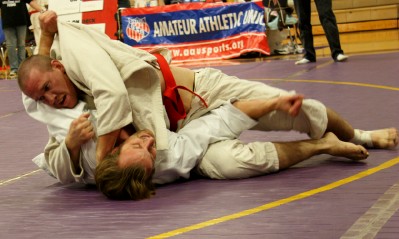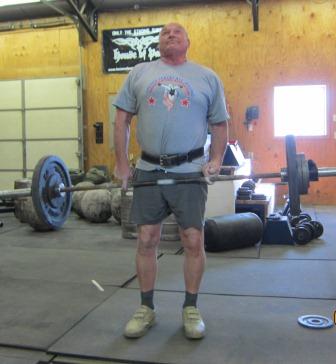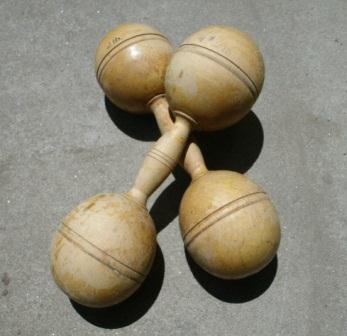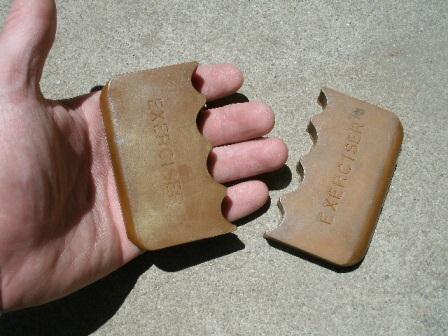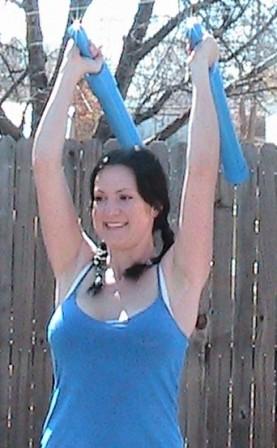Gracie Judo Club RD
by Jarrod Fobes
MEET RESULTS – GRACIE JUDO CLUB RECORD DAY
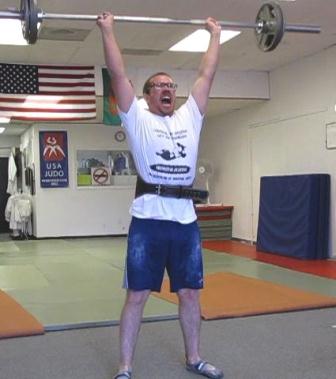
Jarrod Fobes, the meet director for the Gracie Judo Club Record Day, performs a USAWA record in the Miller Clean and Jerk.
We had a small but dedicated turn out Saturday. Dan Wagman stepped out of retirement for “just one more” record day (I suspect that Dan is retired from lifting the same way I am retired from fighting). Newcomer Evan Sioros came and set a couple of records as he learned some of the lifts, but it was all Ruth Jackson’s show as she set a whopping 43 records! Rather she set records on 43 lifts, setting and crushing records in both the Master’s and Open categories. I myself broke the bone-head record. In the middle of the lifting I decided to set a repetition record for chin-ups. I managed 18 reps, however I forgot that the rules state that “the weight of the lifter is not factored into the overall weight of the lift”. So if any math whiz out there can figure out how to give me a record for pulling 18 reps of zero weight, I’ll be your friend for life!
MEET RESULTS
Gracie Judo Club Record Day
Gracie Judo Club
Littleton, CO
December 1st, 2012
Meet Director: Jarrod Fobes
Officials (1-official system used): Jarrod Fobes, Karena Fobes
Lifts: Record Day
Jarrod Fobes – BWT 190 lbs, AGE 35
Miller Clean and Jerk: 115lbs
Chin up: 45lbs
Pull up: 45lbs
Hack Lift – Middle Fingers: 135lbs
Ruth Jackson – BWT 104 lbs, AGE 50
Crucifix: 22lbs
Lateral Raise – Lying: 32lbs
Lateral Raise -Standing: 22lbs
Swing – Dumbell, Right Arm: 48.5lbs
Swing – Dumbbell, Left Arm: 48.5lbs
Squat – Lunge: 106lbs
Good Morning: 101lbs
Bent Over Row: 90lbs
Deadlift – No Thumb, Right Arm: 81lbs
Deadlift – No Thumb, Left Arm: 81lbs
Deadlift – No Thumbs, Overhand Grip: 155lbs
Deadlift -Ciavattone Grip: 175lbs
Deadlift -Heels Together: 205lbs
Deadlift – No Thumbs: 225lbs
Vertical Bar Deadlift -1 Bar, 2″, Right Hand: 116lbs
Vertical Bar Deadlift – 1 Bar, 2″, Left Hand: 116lbs
Vertical Bar Deadlift – 1 Bar, 1″, Right Hand: 117.25lbs
Vertical Bar Deadlift – 1 Bar, 1″, Left Hand: 117.25lbs
Press – Dumbbell, Right Arm: 36lbs
Press – Dumbbell, Left Arm: 36lbs
Clean & Push Press – 2 Dumbbells: 62lbs
Clean & Press – 2 Dumbbells, Heels Together: 72lbs
Clean and Seated Press: 56lbs
Clean and Press -Heels Together: 71lbs
Cleand and Press -12″ Base: 86lbs
Pinch Grip: 117.2lbs
Rectangular Fix: 50lbs
Curl – Reverse Grip: 55lbs
Curl – Strict: 55lbs
Curl – Cheat: 86lbs
Curl – Cheat, Reverse Grip: 86lbs
Finger Lift -Right Little: 16.25lbs
Finger Lift -Left Little: 16.25lbs
Finger Lift -Right Thumb: 23.75lbs
Finger Lift – Left Thumb: 23.75lbs
Finger Lift – Right Ring: 36.25lbs
Finger Lift – Left Ring: 36.25lbs
Finger Lift – Right Index: 38.75lbs
Finger Lift – Left Index: 38.75lbs
Finger Lift – Right Middle: 43.75lbs
Finger Lift – Left Middle: 43.75lbs
Dan Wagman – BWT 185 lbs, AGE 50
Vertical Bar Deadlift – 1 Bar, 2″, Right Hand: 189lbs
Vertical Bar Deadlift – 1 Bar, 2″, Left Hand: 164lbs
Vertical Bar Deadlift – 1 Bar, 1″, Right Hand: 211lbs
Vertical Bar Deadlift – 1 Bar, 1″, Left Hand: 211lbs
Pinch Grip: 190.5lbs
Hack Lift – Right Arm: 275lbs
Hack Lift – Left Arm: 275lbs
